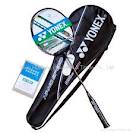To become a skillful player, you need to be able to adapt to different situations. For instance, sometimes the shuttlecock will be behind you; but if you can
adjust your badminton grip, you will still be able to play a good shot.
Grip length
Adjust how high up the handle you hold the badminton racket: long and short grips.
Late forehand overhead
Adjust your grip to play an overhead forehand stroke when the shuttlecock has passed behind you.
Late backhand overhead
Adjust your grip to play an overhead backhand stroke when the shuttlecock has passed behind you.
Smash
Adjust your grip to play a smash when the shuttlecock is somewhat in front of your body.
Advantages of long badminton grips
A long thumb grip
Long badminton grips let you make more powerful strokes, provided that you have time to make a long enough swing.
Long badminton grips also give you a longer reach, so that you can take the shuttlecock earlier or higher.
Advantages of short badminton grips
A short thumb grip
Short badminton grips generally improve your control of the stroke and assist quick responses.
If you only have time for a short swing, then a short grip will give you more power than a long grip.
(There are mechanical reasons for these differences between short and long grips.)
When to use long badminton grips
Smashing with a long grip
Use a long badminton grip for strokes in the rearcourt. In particular, you should make sure that you use a long grip for smashes and clears, because a long grip gives you more power.
Long grips can also be useful for many strokes outside the rearcourt, including strokes at the net, because they give you a longer reach. The small difference in reach might seem insignificant, but taking the shuttlecock early at the net is crucial: a fraction of a second’s delay can turn a winning net kill into a mere net shot.
Generally, professional singles players will use a long grip in all parts of the court. Short grips are sometimes used in singles, but much less commonly than in doubles.
Exceptions
In some situations, a long grip may cramp your badminton strokes, because the shuttlecock is too close to your body. In this case, use a short grip to give yourself room to play the stroke. This can often happen when you return a flick serve in doubles.
When to use short badminton grips
Net play with a short grip
Short badminton grips are useful in the forecourt and midcourt.
Short grips are mainly used in doubles, especially by the forward player when a pair is attacking.
Generally, short grips are not used in singles, even at the net.
Exceptions
Some elite singles players prefer a short grip for spinning net shots, sacrificing reach for control; many players will use a short grip for low or flick serves.
Even in doubles, a long grip is sometimes better at the net than a short grip. This is generally true whenever you need extra reach, such as when you are travelling forwards to kill a loose drop shot.
A warning
Many players use short grips too much. This is especially a problem with juniors who copy elite men’s doubles players.
Introduce short badminton grips into your game gradually, starting with the backhand low serve in doubles, and progressing to doubles net play. Then try using short grips for midcourt drives. Be careful: avoid using short grips for singles or in the rearcourt





